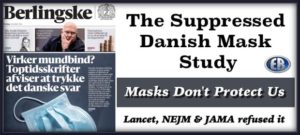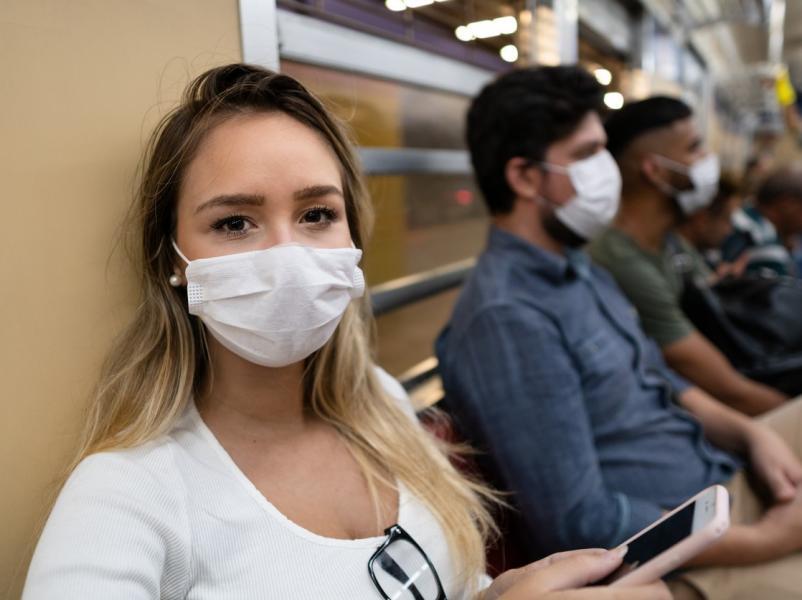The Famous Danish Mask Study: Masks Do Not Protect From Coronavirus
Fri 11:20 am +01:00, 20 Nov 2020
ER Editor: We’re publishing Lockdown Sceptic‘s article on this, plus the content of the scientific paper below that just in case.
The Danish text in the meme (Virker mundbind? Toptidsskrifter afviser at trykke det danske svar) translates as ‘Does a bandage work? Top magazines refuse to print the Danish answer’.
This is linked to below, but the report by Swiss Policy Research reveals the following:
For weeks, media and researchers all over the world have been awaiting the publication of a large Danish study on the effect – or lack thereof – of walking with facemasks in public spaces during the corona pandemic.
Now one of the researchers involved in the study can report that the finished research result has been rejected by at least three of the world’s leading medical journals.
These are The Lancet, The New England Journal of Medicine and the American Medical Association’s journal JAMA.
“They all said no,” says Professor, MD and chief medical officer at the research department at North Sealand Hospital, Christian Torp-Pedersen.
…
The study was launched at the end of April following a grant of 5 million kroner from the Salling Funds. It involved as many as 6,000 Danes, half of whom had to wear facemasks over a longer period of time in public spaces. The other half was selected as a control group.
A larger proportion of the test participants were employees of Salling Group’s supermarkets: Bilka, Føtex and Netto.
The study and its size are unique in the world, and the aim was once and for all to try to clarify the extent to which the use of facemasks in public spaces provides protection against corona infection.
…
However, if the Danish research result is indeed “controversial”, and if it is believed that no evidence has been found of any major effect of facemask use in public spaces, it will be highly spectacular.
For in that case, one must question the expediency of the fact that the vast majority of the world’s population currently walks around with a mask in their pocket or on their face.
…
“This is the world’s largest study of its kind and it is expected to be an important factor in the basis of regulatory decisions regarding mask use.”
Henning Bundgaard, Professor and Chief Medical Officer, Rigshospitalet
********
Danish Mask Study: Masks Do Not Protect From Coronavirus
LOCKDOWN SCEPTICS
The suppressed Danish mask study – the largest randomised controlled trial to date that had been rejected by three top journals, apparently on political grounds (read the interview with the authors here) – was finally published yesterday.
The headline result is that in the study masks do little or nothing to lower the infection rate. It found a 2.1% vs 1.8% infection rate for unmasked vs masked groups (with around 3,000 participants in each group initially). However, due to low virus prevalence, these figures correspond to only 53 and 42 participants respectively so the authors had to state that the result is not statistically significant (too few infections to be confident it’s not random).

The most striking finding is that when you look at participants who report wearing face masks “exactly as instructed” as opposed to just “predominantly as instructed,” the proportion infected rises from 1.8% to 2.0% (22 participants). This is the wrong way round – if masks are helping, using them better should reduce infections – and 2.0% is almost identical to the 2.1% infected without masks. This suggests the lower figure for all mask wearers was probably just noise.
A few more observations:
- Reported symptoms did not differ between those who wore masks and those who didn’t, giving no support to the masker theory that masks make the disease milder (or provide immunity) by reducing viral load.
- For other respiratory viruses, the study found 0.5% vs 0.6% infection rate (9 vs 11 participants) for masks vs non-masks, so again almost the same, supporting the primary finding.
- Although 91 participants reported someone else in their household contracting COVID-19 during the study (52 masked and 39 non-masked), only three reported then catching it themselves – two with masks and one without. Strange, because the home is usually found to be a primary source of transmission.
- The study looks at protecting the wearer, not others (i.e., source control, the usual justification for masks). It couldn’t look at source control as the study took place in April and May before masks were mandated or in widespread use.
With insufficient infections to achieve statistical significance, despite involving over 6,000 participants, the study leaves a need for further studies that are large enough and in areas of high enough prevalence to achieve statistical significance.
We can’t draw firm conclusions about precise differences in infection rates from this study. However, we can say that wearing a surgical mask even “exactly as instructed” does not appear to prevent infection completely – does not appear to prevent it much at all. And if that’s the case for surgical masks, how much more for cloth masks?
Also worth noting that mask mandates have not prevented the autumn surges in many countries around the world, and that maskless Sweden’s autumn rise in infections came somewhat later than elsewhere. None of this is supportive of masks.
The lead author of the study, Dr Henning Bundgaard, a cardiologist at the University of Copenhagen, tersely said: “Our study gives an indication of how much you gain from wearing a mask: Not a lot.”
Reading between the lines it seems the authors had to tone down their scepticism to get it past the editors and reviewers. They are at pains to stress that “this trial did not address the effects of masks as source control or as protection in settings where social distancing and other public health measures are not in effect.” The strongest they are allowed to get in their discussion is: “While we await additional data to inform mask recommendations, communities must balance the seriousness of COVID-19, uncertainty about the degree of source control and protective effect, and the absence of data suggesting serious adverse effects of masks.”
Absence of (scientific) evidence is not, of course, evidence of absence, and there is plenty of anecdotal evidence of the harm wearing masks does, as Professor Sucharit Bhakdi explains here regarding the impact of reducing oxygen supply on people with high blood pressure.
One Lockdown Sceptics reader got in touch yesterday with a powerful personal illustration of this.
I thought you might be interested in this account of my trip to A&E the other night, after a suspected heart attack – false alarm, thanks for asking, I’m fine…
On arrival in A&E I was handed a face mask to put on – which I did, feeling a sort of civic duty as it was a set of special circumstances – and my underlying medical condition was at least in the right place to be resolved if I had any problems (I have had a heart attack previously, so have to ensure I do not suffer from cardiac ischaemia). Up to this point, when I had had my readings taken, both by the paramedics immediately after the incident at home, in the ambulance, and on my arrival in the hospital, my blood oxygen levels had been fine (97 – in case you are unaware, the normal range is 95 to 100 and hypoxia begins at 90).
After half an hour or so, I was moved into a side room – at which point, I took the mask off of one ear, as I was having trouble breathing properly through it, only putting it back on when a member of staff came in to check on me.
After I had been there for an hour, a nurse came to take my readings again and I had put the mask back on whilst she set things up and, after a couple of minutes of wearing the mask, my readings were taken and my blood oxygen had dropped to 93 – a drop of four points (there are only five between normal and hypoxia).
The first reaction of the nurse was to say that they were concerned because of the drop in oxygen, but that “it was probably just because of the mask”. I took it off one ear again so I could breathe normally and literally with each breath the reading went up by one, so after four breaths, I was back to where I had been without the mask.
From that point on, I left the mask off and, each time my hourly readings were taken, it remained at 97, so clearly the drop in oxygen levels was down to the mask. During this time – and I was there for six hours – not a single member of staff told me to put the mask back on and indeed I saw several staff sitting behind desks or in corridors with their masks removed.
There is a certain irony that before being taken to A&E, I had self-medicated with a spray to open my blood vessels to increase blood flow to the heart, but on admission to hospital I was given a piece of what can only be described as window dressing (or perhaps set dressing would be a more apt analogy) which actually counteracted the medication I had taken to ensure I did not suffer from ischaemia.
What I’d like to know is why extreme interventions with serious collateral harm like coercive mask-wearing and other restrictions on liberty don’t have to meet the same rigorous safety and efficacy criteria as vaccines and drugs. So-called “public health” needs a serious overhaul.
Stop Press: The Swiss Doctor has written about the Danish mask study, as well as other mask studies, here.
continue reading……..
The Famous Danish Mask Study: Masks Do Not Protect From Coronavirus










